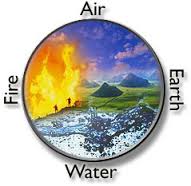Dhātu
'elements', are the ultimate constituents of a whole.
(1) The 4 physical elements (dhātu or mahā-bhūta), popularly called:
- earth, (pathavī-dhātu)
- water, (āpo-dhātu)
- fire, (tejo-dhātu)
- wind, (vāyo-dhātu)
are to be understood as the primary qualities of matter.
In Vis.M. XI, 2 the four elements are defined thus:
"Whatever is characterized:
- by hardness (thaddha-lakkkhana) is the earth or solid-element;
- by cohesion (ābandhana) or fluidity, the water-element;
- by heating (paripācana), the fire or heat-element;
- by strengthening or supporting (vitthambhana), the wind or motion-element.
All four are present in every material object, though in varying degrees of strength. If, for instance, the earth element predominates, the material object is called 'solid', etc. - For the analysis of the 4 elements, s. dhātu-vavatthāna.
(II) The 18 physical and mental elements that constitute the conditions or foundations of the process of perception, are:
1. visual organ (eye)
2. auditory organ (ear)
3. olfactory organ (nose)
4. gustatory organ (tongue)
5. tactile organ (body)
6. visible object
7. sound or audible object
8. odour or olfactive object
9. gustative object
10. body-impression
11. eye-consciousness
12. ear-consciousness
13. nose-consciousness
14. tongue-consciousness
15. body-consciousness
16. mind-element
17. mind-object (mano-dhātu) (dhamma-dhātu)
18. mind-consciousness-element (mano-viññāna-dhātu)
1-10 are physical; 11-16 and 18 are mental; 17 may be either physical or mental.
16 performs the function of advertence (āvajjana) towards the object at the inception of a process of sensuous consciousness; it further performs the function of receiving (sampaticchana) the sensuous object.
18 performs, e.g., the function of investigation (santīrana), determining (votthapana) and registering (tadārammana) - (for its other functions, s. Table I).
For the 14 functions of consciousness, s. viññāna-kicca.
Cf. M. 115; S. XIV and especially Vibh. II (Guide p. 28f), Vis.M. XV, 17ff.
Of the many further groupings of elements (enumerated in M.115), the best known is that of the 3 world-elements:
- the sensuous world (kāma-dhātu),
- the fine-material world (rūpa-dhātu),
- the immaterial world (arūpa-dhātu);
further the six-fold group:
- solid, (pathavī)
- liquid, (āpo)
- heat, (tejo)
- motion, (vāyo)
- space, (ākāsa)
- consciousness (viññāna; s. above I), described in M.140; see also M.112.
